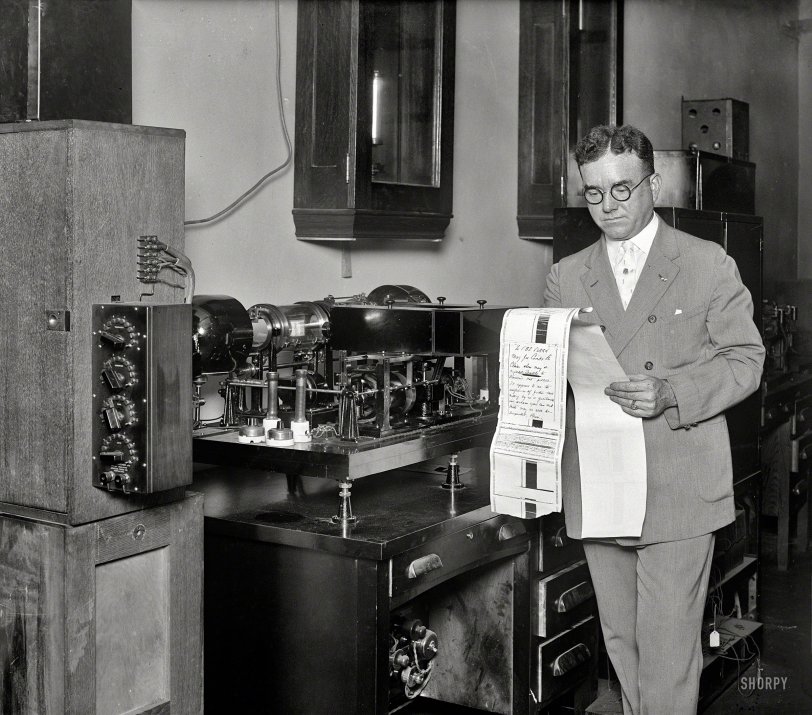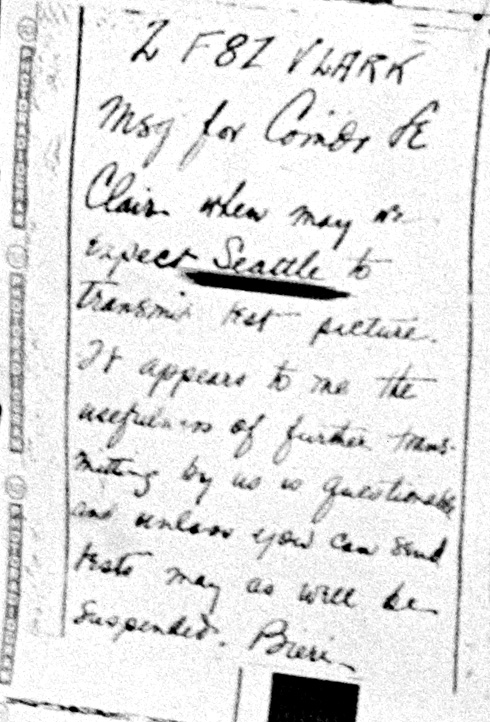


Framed or unframed, desk size to sofa size, printed by us in Arizona and Alabama since 2007. Explore now.
Shorpy is funded by you. Patreon contributors get an ad-free experience.
Learn more.

- Baldwin 62303
- Baldwin VO-1000
- Cold
- No expense spared
- Tough Guys
- Lost in Toyland
- And without gloves
- If I were a blindfolded time traveler
- Smoke Consumer Also Cooks
- Oh that stove!
- Possibly still there?
- What?!?
- $100 Reward
- Freeze Frame
- Texas Flyer wanted
- Just a Year Too Soon
- WWII -- Replacing men with women at the railroad crossing.
- Yes, Icing
- You kids drive me nuts!
- NOT An Easy Job
- I wonder
- Just add window boxes
- Icing Platform?
- Indiana Harbor Belt abides
- Freezing haze
- Corrections (for those who care)
- C&NW at Nelson
- Fallen Flags
- A dangerous job made worse
- Water Stop
Print Emporium
Just the Fax: 1927

Washington, D.C., 1927. No caption on this Harris & Ewing glass plate of what seems to be facsimile equipment. View full size.
Radiofax
Radiofax weather charts for the benefit of ships at sea are still broadcast worldwide by organizations like the NOAA and the Deutscher Wetterdienst.
Nervous Fountain Pen
I'm continually impressed by the quality of technical writing in the newspapers of the time. The box on the left with the four dials is a decade resistance box, perhaps used for tuning.
Washington Post, October 18, 1925.Photoradio New RCA Development
Means for Transmitting the Actual Events to Listeners-In.
“Photoradio” means the sending of photographs or other pictures by means of a radio transmitter to a distance, and receiving these wherever suit suitable apparatus may by located. Thus, like broadcasting, a million persons could receive the same picture at the same time, provided only, again as in broadcasting, that they possessed suitable apparatus for this work.
Now, photoradio is not by any means “tele-vision.” By the latter we mean the equivalent of “radio moving pictures,” or, more exactly, the ability to see, by radio, some distant event just as it would appear to the eye of some one near it at the moment. Photoradio is the first step toward the attainment, perhaps not so many years in the distance, of real tele-vision, but it admittedly is but a first step.
In the Radio Corporation of America's system, a photograph is taken of whatever scene of person's face or printed page, or other picture one may desire to transmit. This negative is placed in a special device, and by means described in detail in later paragraphs, the lights and shades of this picture are sent, square inch by square inch, in the form of high-speed dots sent out by a radio transmitter. At the receiver, or as many receivers as may be in operation, the received dots actuate a relay, and this, in turn, causes a “nervous fountain pen” to print on a paper record, dot by dot, identical as to shade and position, the impulses sent out from the sending station. Thus, in time—it takes about twenty minutes for an ordinary photograph—the entire picture is transmitted and received.
The entire process depends essentially on three factors. First, the ability to control a radio transmitter by different degrees of light passing through a negative or other screen. This is found in the “light sensitive cell,” a device which will allow electric current to pass through it when light is shining on its electrodes, and which shuts off this current the moment light ceases. Second, a method for having radio currents control a relay. The radiotron, or vacuum tube detector, does this. A relay placed in its plate circuit will respond when incoming signals affect its grid, and of course any other electric circuit that we may desire. The third requirement, and the most difficult one to attain, is the exact synchronism of the speed of the carrier for the transmitted negative and the carrier for the received record.
Naval Communications
A curious oddity of a photo staged to demonstrate the marvel of a new widget containing a message which questions the usefulness of the same device. I guess he didn't expect the photograph to resolve the text. The February 13, 1927 Washington Post reports the imminent promotion of a Lt. Comdr. Hugh P. LeClair.
Washington Post, May 24, 1927.New Radio Service Utilized by Navy
Photoradiogram is Sent by Admiral Eberle
to Maneuvering Ship.A new experimental radio service in the Navy was opened yesterday by Admiral E.W. Eberle, chief of naval operations, who sent the first official message over the new photoradiogram apparatus installed recently at the Navy Department to the similar one on the U.S.S. Seattle, flagship of the United Sates fleet at Newport R.I.
His message to Admiral Charles F. Hughes, fleet commander, stated “this first message by photoradio transmission between the Navy Department and the flagship of the commander in chief, engaged in maneuvers off the New England coast, begins a service which it is hoped will have a far reaching effect on naval communications. ”
A copy of the message as received showed that some of the words were missing due to the other radio impulses, but great hope is held for conversion of the commercial apparatus to naval use.
Fax is older than you might think...
Here's some of the history of fax:
Photoradiogram
Photoradiogram was one of the first facsimile devices, according to this wiki article about Richard H. Ranger, its inventor.
How I read it
Here's is my reading of the message miracle of the 20th century:
2 FBZ VLARK
Msg for Comdr Le
Clair When may we
expect Seattle to
transmit test picture.
It appears to me the
usefulness of further trans-
mitting by us is questionable
and unless you can send
tests may as well be
suspended. Biere
[Here's a close-up. -tterrace]
Thanks to stanton_square and tterrace for helping to fill in the blanks.

Motors, Gears and Wormdrives
Let me stick my hand in there to clear that debris.
























On Shorpy:
Today’s Top 5